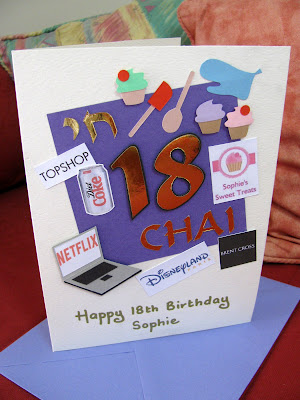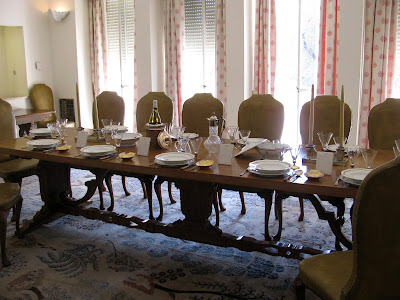Back in May, on
International Museum Day, the youngest son and I decided to visit the Weizmann House, the home of the first
President of Israel,
Chaim Weizmann, and first
First Lady,
Vera Weizmann. Chaim Weizmann was a world-renowned scientist, President of the World Zionist Organisation (1921-1931 and 1935-1946), first President of the State of Israel (1949-1952), and founder and first President of the
Weizmann Institute of Science. Vera Weizmann was a paediatrician. Their home sits up on a hill in
Rehovot, one of the first communities founded in the modern State of Israel. It was designed in 1937 by the acclaimed Jewish architect
Erich Mendelsohn who had fled Germany when the Nazis came to power. Mendelsohn set up an office in Palestine and built some of Israel's most important buildings including the
Hadassah Medical Centre on Mount Scopus and the
Rambam Medical Centre in Haifa. He later decamped to the U.S. in 1941. The Weizmann House was considered ultra modern in its day and is a rare architectural gem in Israel. The house gives a glimpse into the world of the Weizmanns and the famous people they received in their home.
The Weizmanns were born in Russia, studied in Germany and Switzerland, and lived for some 30 years in England. They chose to build their home in Israel, in Rehovot, next to the Daniel Sieff Research Institute, which later became the Weizmann Institute of Science, Israel's foremost scientific establishment and think tank.
In 1934 Chaim Weizmann, who was then living in England, asked Mendelsohn to plan his home in Israel. After negotiations which lasted for about a year and much discussion over costs, the Weizmanns took residence in January 1937, and from 1949 - the election of Dr. Weizmann to the Presidency of Israel - until his death three years later, the house functioned as the official residence of the President of Israel. After Weizmann’s death, the presidential residence moved to Jerusalem. Weizmann's Rehovot home was adapted into a museum in 1978 and underwent further renovations in 1999, during the presidency of the Weizmanns' nephew,
Ezer Weizmann.
The Weizmann House was designed in keeping with the
International Style. The structure is simple and is designed to stringent proportions. In the centre of the house is an airy sinuous stairwell, designed like a tower looking out into the distance. The spiral structures seen in the shells of sea mollusks served as the basis for Mendelsohn's design. At the stairwell's base are three rectangles: an extensive and lavishly furnished library, a drawing room, and, outside, a columned courtyard containing a swimming pool. High on the thick white walls are small round windows resembling portholes of a ship, which let in soft light while preventing overheating.




The interior design of the house, combining the atmosphere of the Weizmann's English roots with their Zionist aspirations and international relations, was decided upon by Vera Weizmann, much to the dismay of the architect, who wanted to plan both its furniture and its interior decoration. Vera Weizmann thanked Mendelsohn for the splendid house he had designed but insisted on decorating its interior, rather unfortunately introducing Victorian furniture into this pearl of modernism. All the furniture and objects in the house are original pieces; most were imported from England or France. Some of the items date from the 18th and 19th centuries. The art collection includes items bought by Vera Weizmann and gifts received by the couple, including the portrait of Chaim Weizmann by Sir Oswald Birley, 1934, below, which was a gift to Chaim Weizmann on his 60th birthday from
Lord Marcus Sieff.
The house has been preserved intact, with the library, rugs, paintings and gifts received during the President’s period of office all displayed in their original location, as they would have been when the Weizmanns lived there. You can even see the GE refrigerator still in the kitchen, said to have been the first refrigerator in Israel!
Our tour of the house included the entrance floor (entrance hall, dining room, library, drawing room, and kitchen area) and the upper floors (bedrooms and washrooms). The cloakroom at the front entrance now contains an exhibit on members of the Weizmann family, Dr. Vera Weizmann’s public activity, and the Weizmanns’ son Michael, a pilot killed in World War II. It also displays some of Dr. Chaim Weizmann’s personal belongings including his Israeli passport, numbered ‘00001’. Never has founding a country had so clear an effect on one’s travel papers!
There is no memorial in Israel in the name of Michael Weizmann, the younger son of Chaim and Vera Weizmann, who fought in the Royal Air Force during World War II and his plane was shot down over the Bay of Biscay. Vera planed to build a sanatorium in Michael's name for wounded soldiers on a piece of property the family owned, but when a donor came with an offer to significantly extend the size of project in exchange for naming the sanatorium in his name, she readily agreed, for the sake of soldiers she so much cared about.


After touring the house we stepped outside to visit the grounds and take a close look at the
Royal Ford Lincoln Cosmopolitan car, displayed inside a temperature/humidity-controlled glass enclosure. In 1950,
Henry Ford II presented Dr. Chaim Weizmann with the car, one in a series of 18 of its type, manufactured according to specifications drawn up for the President. It served as the official car of the President of Israel.
The Weizmann estate includes an expansive garden sprawling over 44 dunams and was also designed by Erich Mendelsohn, who was known as a great lover of nature. The vegetation is varied and includes numerous plants common to the region such as citrus, olives, figs and oaks, as well as tropical plants such as mango and persimmon. In contrast to the house’s straight lines, the garden’s trails are curved. An exception is the straight path leading to the graves of the Weizmanns, paved after the President’s death. Weizmann asked to be buried in the garden of the estate next to his house. At the request of Vera Weizmann, in memory of their son, his tombstone, designed by sculptor
Moshe Ziffer, was fashioned after the tombstones of missing soldiers in Great Britain, where their son’s name is engraved. Chiseled in the centre is the emblem of the Weizmann Institute of Science (the Tree of Life). In 1966, fourteen years after Chaim Weizmann’s death, Vera Weizmann was buried by his side.










































































